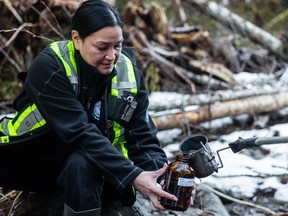Opinion: The B.C. floods of 2021 blurred the distinction between fish habitat and human communities as contaminants from human activities washed unfettered into streams and rivers

In November 2021, we viewed with alarm the unfolding flood disaster in southern B.C.
With government agencies dealing with the urgent public safety needs of the day, the health of fish habitat ranked low on the list of priorities. But as floodwaters rose, the distinction between terrestrial and aquatic habitats blurred, salmon and sturgeon swam across farmers’ fields, and contaminants from human activities washed unfettered into streams and rivers.
Sign up to know what's really happening by reading daily editorials and commentary by British Columbia's opinion leaders
Thanks for signing up!
A welcome email is on its way. If you don't see it, please check your junk folder.
The next issue of Vancouver Sun Informed Opinion will soon be in your inbox.
We need to understand the extent to which floods further degrade water quality in fish habitat.
At Raincoast Conservation Foundation, we responded to concerns expressed by the Sumas First Nation, the Indigenous-led Lower Fraser Fisheries Alliance and S’ólh téméxw Stewardship Alliance, and the Pacific Salmon Foundation by mobilizing an emergency response team to sample and analyze water samples from the flood-ravaged Sumas area. These entities would provide much-needed funding, alongside the federal Department of Fisheries and Oceans and the B.C. Ministry of Environment and Climate Change Strategy.
The team collected samples from Sumas waterways following the floods, and submitted these for comprehensive contaminant analysis. With few pre-flood baseline data against which we could compare our findings, we ended up painting a picture of just how degraded fish habitat had become, with or without the intervention of the floods.
While many agencies have roles to play when it comes to water, the silos designed to distinguish among ministerial mandates meant that salmon — those enigmatic fish to which we all ascribe value — risked falling into the cracks. Salmon must navigate contaminated corridors from their natal streams to the ocean and back, transiting several regulatory and physical boundaries.
Our findings painted a bleak picture of the health of the waterways meandering through the remnants of Sumas Lake, drained nearly 100 years ago by the Barrowtown Pump Station. We found that cocaine, sucralose, Ibuprofen, the tire chemical 6-PPD quinone, pesticides, hydrocarbons and perfluorinated substances were present in the area.
In 29 samples taken from Sumas waters, there were 59 instances where the levels of several metals, pesticides and hydrocarbons exceeded established Canadian Environmental Quality Guidelines. This meant that among those contaminants for which guidelines exist in Canada, a clear and present danger for salmon was lurking in these floodwaters.
And while guidelines serve to inform our understanding of risks to aquatic life, no guidelines exist for 77 per cent of the contaminants that we sought to measure. This meant that we have no sanctioned means of determining whether the levels of such things as cocaine, sucralose, or 6-PPD quinone are below, at, or above levels of concern to salmon.
With the derivation of new environmental quality guidelines taking years, if not decades, this has the potential to make people think that the concentrations of these contaminants are safe for fish. Pharmaceuticals and veterinary drugs are designed to affect physiological systems in humans and livestock. Pesticides are designed to kill unwanted weeds and pests; nutrients are designed to make plants grow.
Once these get into fish habitat, the principles of comparative toxicology suggest we have some reason for concern.
Before the arrival of settlers, the Sumas Prairie was a lake — a lake that quadrupled in size every fall as the rains fell. A lake that teemed with salmon, whitefish, sturgeon, freshwater clams and migratory birds. For the Sto:lo peoples, the banks of this lake were not only home, but a vital means to access the lake’s resources.
The “re-emergence” of Sumas Lake killed farm animals, destroyed property, and threatened livelihoods. It also provided an opportunity to take stock of what has become of fish habitat here.
Fish today continue to eke out an existence in the waterways of the former Sumas Lake. But the migratory corridors of our prized salmon have changed, with dikes, flood-control barriers and pumps channelling and draining their habitat.
As climate change looms large, the catastrophic B.C. floods of 2021 have reminded us of Mother Nature’s power, and provided us with an opportunity to consider questions worth posing: How can we identify contaminants of concern in fish habitat? Can we better protect fish habitat from excess nutrients, pesticides, hydrocarbons and domestic wastewater? Can we design a win-win green infrastructure agenda that protects both communities and fish habitat?
We can all do better — our future depends on it.
Peter S. Ross is senior scientist at Raincoast Conservation Foundation and director of its healthy waters program.
Letters to the editor should be sent to sunletters@vancouversun.com. The editorial pages editor is Hardip Johal, who can be reached at hjohal@postmedia.com.
CLICK HERE to report a typo.
Is there more to this story? We’d like to hear from you about this or any other stories you think we should know about. Email vantips@postmedia.com.
More news, fewer ads: Our in-depth journalism is possible thanks to the support of our subscribers. For just $3.50 per week, you can get unlimited, ad-lite access to The Vancouver Sun, The Province, National Post and 13 other Canadian news sites. Support us by subscribing today: The Vancouver Sun | The Province.


